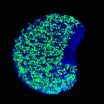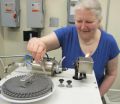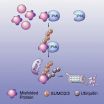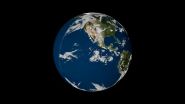(Press-News.org) Artificially stimulating a brain region believed to play a key role in learning, reward and motivation induced monkeys to change which of two images they choose to look at. In experiments reported online in the journal Current Biology, researchers from Massachusetts General Hospital (MGH) and the University of Leuven in Belgium confirm for the first time that stimulation of the ventral tegmental area (VTA) – a group of neurons at the base of the midbrain – can change behavior through activation of the brain's reward system.
"Previous studies had correlated increased activity in the primate VTA with positive events experienced by the animal but could not prove that VTA activity actually caused behavioral changes," says Wim Vanduffel, PhD, of the Martinos Center for Biomedical Imaging at MGH, corresponding author of the Current Biology paper. "Studies in rodents have shown that artificially manipulating VTA activity strongly influences behavior, and our work has bridged the gap between rodent and primate." Vanduffel is also head of the Laboratory for Neuro- and Psychophysiology at the University of Leuven.
To investigate the direct impact of VTA activation on primate behavior, the research team used high-resolution magnetic resonance imaging to guide the placement of microelectrodes within the VTAs of macaque monkeys. In the initial set of experiments, the animals were presented with a pair of images – for example a star and a ball – and could freely chose to look at one image or the other, with their choice measured by their eye movement. Each animal was trained by means of a juice reward to look first at a white square at the center of the visual field and then at either of the paired images.
After establishing each animal's preference, based on which image was looked at most frequently, mild stimulation was applied to the VTA when the animal happened to look at the initially nonpreferred image. Soon the animal's preference changed, and it most frequently looked at what previously had been the less favored image. When the VTA stimulation was then applied to the initially preferred image, the monkeys soon changed their preference back to the original choice.
In a second set of experiments, after the initial image preference was established, an animal watched a 20-minute video, during which the two images were randomly presented every 5 seconds. Whenever the initially nonpreferred image was presented, it was accompanied by mild VTA stimulation. Subsequent repetition of the preference test showed that the animal's choice had shifted to the image reinforced by VTA stimulation.
Functional MR imaging taken while the animals received either a juice reward or VTA stimulation revealed that both induced activation of brain regions that previous studies in humans and other primates have associated with reward signaling by means of the neurotransmitter dopamine. The level of VTA stimulation required to activate these structures was considerably less than the amount required to reinforce or change behavior in the earlier experiments.
"Our study showed that the timing of VTA stimulation is important – when stimulation happens immediately after an action is performed, the monkey is more likely to perform that action – and that it applies 'value' to a particular stimulus and motivates future behavior," says Vanduffel, who is an assistant professor of Radiology at Harvard Medical School. "Other studies have implicated the VTA in learning based on negative, as well as positive reinforcement, and a recent rodent study found that increasing VTA activation can relieve depression, possibly by increasing motivated behavior. Our findings lay the groundwork for further investigation of the role of the VTA in reinforcing and regulating motivated behavior."
INFORMATION:
John Arsenault, PhD, of the Martinos Center at MGH and the University of Leuven, is first author of the Current Biology paper. Additional co-authors are Samy Rima and Heiko Stemmann, both at the University of Leuven.
Massachusetts General Hospital, founded in 1811, is the original and largest teaching hospital of Harvard Medical School. The MGH conducts the largest hospital-based research program in the United States, with an annual research budget of more than $785 million and major research centers in AIDS, cardiovascular research, cancer, computational and integrative biology, cutaneous biology, human genetics, medical imaging, neurodegenerative disorders, regenerative medicine, reproductive biology, systems biology, transplantation biology and photomedicine.
Activation of brain region can change a monkey's choice
Study is first to confirm that activity in ventral tegmental area affects primate behavior
2014-05-29
ELSE PRESS RELEASES FROM THIS DATE:
Fertility: Sacrificing eggs for the greater good
2014-05-29
Baltimore, MD— A woman's supply of eggs is a precious commodity because only a few hundred mature eggs can be produced throughout her lifetime and each must be as free as possible from genetic damage. Part of egg production involves a winnowing of the egg supply during fetal development, childhood and into adulthood down from a large starting pool. New research by Carnegie's Alex Bortvin and postdoctoral fellow Safia Malki have gained new insights into the earliest stages of egg selection, which may have broad implications for women's health and fertility. The work is reported ...
NASA missions let scientists see moon's dancing tide from orbit
2014-05-29
Scientists combined observations from two NASA missions to check out the moon's lopsided shape and how it changes under Earth's sway – a response not seen from orbit before.
The team drew on studies by NASA's Lunar Reconnaissance Orbiter, which has been investigating the moon since 2009, and by NASA's Gravity Recovery and Interior Laboratory, or GRAIL, mission. Because orbiting spacecraft gathered the data, the scientists were able to take the entire moon into account, not just the side that can be observed from Earth.
"The deformation of the moon due to Earth's pull ...
UNL team explores new approach to HIV vaccine
2014-05-29
Lincoln, Neb., May 29, 2014 -- Using a genetically modified form of the HIV virus, a team of University of Nebraska-Lincoln scientists has developed a promising new approach that could someday lead to a more effective HIV vaccine.
The team, led by chemist Jiantao Guo, virologist Qingsheng Li and synthetic biologist Wei Niu, has successfully tested the novel approach for vaccine development in vitro and has published findings in the international edition of the German journal Angewandte Chemie.
With the new approach, the UNL team is able to use an attenuated -- or weakened ...
A tool to better screen and treat aneurysm patients
2014-05-29
New research by an international consortium, including a researcher from Lawrence Livermore National Laboratory, may help physicians better understand the chronological development of a brain aneurysm.
Using radiocarbon dating to date samples of ruptured and unruptured cerebral aneurysm (CA) tissue, the team, led by neurosurgeon Nima Etminan, found that the main structural constituent and protein – collagen type I – in cerebral aneurysms is distinctly younger than once thought.
The new research helps identify patients more likely to suffer from an aneurysm and embark ...
Gender stereotypes keep women in the out-group
2014-05-29
New Rochelle, NY, May 29, 2014—Women have accounted for half the students in U.S. medical schools for nearly two decades, but as professors, deans, and department chairs in medical schools their numbers still lag far behind those of men. Why long-held gender stereotypes are keeping women from achieving career advancement in academic medicine and what can be done to change the institutional culture are explored in an article in Journal of Women's Health, a peer-reviewed publication from Mary Ann Liebert, Inc., publishers. The article is available free on the Journal of Women's ...
Caught by a hair
2014-05-29
Crime fighters could have a new tool at their disposal following promising research by Queen's professor Diane Beauchemin.
Dr. Beauchemin (Chemistry) and student Lily Huang (MSc'15) have developed a cutting-edge technique to identify human hair. Their test is quicker than DNA analysis techniques currently used by law enforcement. Early sample testing at Queen's produced a 100 per cent success rate.
"My first paper and foray into forensic chemistry was developing a method of identifying paint that could help solve hit and run cases," explains Dr. Beauchemin. "Last year, ...
Neural transplant reduces absence epilepsy seizures in mice
2014-05-29
New research from North Carolina State University pinpoints the areas of the cerebral cortex that are affected in mice with absence epilepsy and shows that transplanting embryonic neural cells into these areas can alleviate symptoms of the disease by reducing seizure activity. The work may help identify the areas of the human brain affected in absence epilepsy and lead to new therapies for sufferers.
Absence epilepsy primarily affects children. These seizures differ from "clonic-tonic" seizures in that they don't cause muscle spasms; rather, patients "zone out" or stare ...
Drop in global malnutrition depends on ag productivity, climate change
2014-05-29
WEST LAFAYETTE, Ind. - Global malnutrition could fall 84 percent by the year 2050 as incomes in developing countries grow - but only if agricultural productivity continues to improve and climate change does not severely damage agriculture, Purdue University researchers say.
"The prevalence and severity of global malnutrition could drop significantly by 2050, particularly in the poorest regions of the world," said Thomas Hertel, Distinguished Professor of Agricultural Economics. "But if productivity does not grow, global malnutrition will worsen even if incomes increase. ...
Penn study shows how misfolded proteins are selected for disposal
2014-05-29
PHILADELPHIA – It's almost axiomatic that misfolded proteins compromise how cells normally function and cause debilitating human disease, but how these proteins are detected and degraded within the body is not well understood. Neurodegenerative diseases – including Alzheimer's disease, Parkinson's disease, amyotrophic lateral sclerosis (Lou Gehrig's disease), Huntington's disease, and spinocerebellar ataxias – exact a devastating toll on aging populations throughout the world.
"Yet, there is virtually no cure for any of these diseases, and clinical trials have yielded ...
Tropical Storm Amanda gets bisected and animated by NASA's CloudSat
2014-05-29
VIDEO:
This animation shows how Cloudsat was able to get the image shown.
Click here for more information.
Tropical Storm Amanda continues to weaken in the eastern Pacific from dry air and wind shear. NASA's CloudSat satellite captured a view of the storm from the side revealing heavy precipitation when the storm was the most powerful May Eastern Pacific on record.
NASA's CloudSat satellite flew over Hurricane Amanda in the east Pacific on May 25, 2014 at 2100 UTC (5 p.m. EDT) ...
LAST 30 PRESS RELEASES:
SwRI upgrades nuclear magnetic resonance laboratory for pharmaceutical R&D
House sparrows in northern Norway can help us save other endangered animals
Crohn's & Colitis Foundation survey reveals more than 1/3 of young adults with IBD face step therapy insurance barriers
Tethered UAV autonomous knotting on environmental structures for transport
Decentralized social media platforms unlock authentic consumer feedback
American Pediatric Society announces Vanderbilt University School of Medicine as host institution for APS Howland Visiting Professor Program
Scientists discover first method to safely back up quantum information
A role for orange pigments in birds and human redheads
Pathways to net-zero greenhouse gas emissions for Southeast Asia
A JBNU–KIMS collaborative study on a cost-effective alloy matches superalloys for power plants and energy infrastructure
New study overturns long-held model of how plants coordinate immune responses.
New AI model predicts disease risk while you sleep
Scientists discover molecular ‘reshuffle’ and crack an 80-year-old conundrum
How stressors during pregnancy impact the developing fetal brain
Electrons lag behind the nucleus
From fungi to brain cells: one scientist's winding path reveals how epigenomics shapes neural destiny
Schizophrenia and osteoporosis share 195 genetic loci, highlighting unexpected biological bridges between brain and bone
Schizophrenia-linked genetic variant renders key brain receptor completely unresponsive to both natural and therapeutic compounds
Innovative review reveals overlooked complexity in cellular energy sensor's dual roles in Alzheimer's disease
Autism research reframed: Why heterogeneity is the data, not the noise
Brazil's genetic treasure trove: supercentenarians reveal secrets of extreme human longevity
The (metabolic) cost of life
CFRI special issue call for papers: New Frontiers in Sustainable Finance
HKU Engineering scholar demonstrates the smallest all-printed infrared photodetectors to date
Precision empowerment for brain "eavesdropping": CAS team develops triple-electrode integrated functional electrode for simultaneous monitoring of neural signals and chemical transmitters during sleep
Single-capillary endothelial dysfunction resolved by optoacoustic mesoscopy
HKU three research projects named among ‘Top 10 Innovation & Technology News in Hong Kong 2025’ showcasing excellence in research and technology transfer
NLRSeek: A reannotation-based pipeline for mining missing NLR genes in sequenced genomes
A strand and whole genome duplication–aware collinear gene identification tool
Light storage in light cages: A revolutionary approach to on-chip quantum memories
[Press-News.org] Activation of brain region can change a monkey's choiceStudy is first to confirm that activity in ventral tegmental area affects primate behavior






